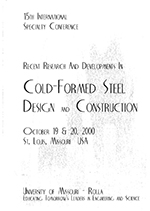Session Dates
19 Oct 2000
Abstract
Steel Scaffolding systems are often constructed from cold-formed circular hollow sections. The beams of this system are normally called "ledgers" and the columns are normally called "standards". To allow the system to be quickly erected on site, "spigot joints" are inserted in the standards. The spigot joints consist of smaller diameter tubes which slide into the larger diameter tubes to provide a safe connection under gravity load. However, the spigot joints may have a lack of fit, and when located midway between the ledgers, they can cause significant out-of-straightness in a standard. This PΔ effect may weaken the standard as a column and lead to a reduced load capacity of the scaffold system. The paper describes tests on sub-assemblages of scaffolding with and without spigot joints. Concentric and eccentric loading eccentricity was also investigated. The results are compared with a nonlinear inelastic finite element frame analysis (program NIFA) developed at the University of Sydney. The nonlinear analysis included special modelling of the spigot joints. The results are also compared with design capacities computed using the Australian Steel Structures standard AS 4100-1998. Conclusions are given regarding the modelling of the spigot joints and the effect of the spigot joints on the strength of scaffolding systems.
Department(s)
Civil, Architectural and Environmental Engineering
Research Center/Lab(s)
Wei-Wen Yu Center for Cold-Formed Steel Structures
Meeting Name
15th International Specialty Conference on Cold-Formed Steel Structures
Publisher
University of Missouri--Rolla
Document Version
Final Version
Rights
© 2000 University of Missouri--Rolla, All rights reserved.
Document Type
Article - Conference proceedings
File Type
text
Language
English
Recommended Citation
Enright, John; Harriss, Robert; and Hancock, Gregory J., "Structural Stability of Braced Scaffolding and Formwork with Spigot Joints" (2000). CCFSS Proceedings of International Specialty Conference on Cold-Formed Steel Structures (1971 - 2018). 2.
https://scholarsmine.mst.edu/isccss/15iccfss/15iccfss-session6/2
Structural Stability of Braced Scaffolding and Formwork with Spigot Joints
Steel Scaffolding systems are often constructed from cold-formed circular hollow sections. The beams of this system are normally called "ledgers" and the columns are normally called "standards". To allow the system to be quickly erected on site, "spigot joints" are inserted in the standards. The spigot joints consist of smaller diameter tubes which slide into the larger diameter tubes to provide a safe connection under gravity load. However, the spigot joints may have a lack of fit, and when located midway between the ledgers, they can cause significant out-of-straightness in a standard. This PΔ effect may weaken the standard as a column and lead to a reduced load capacity of the scaffold system. The paper describes tests on sub-assemblages of scaffolding with and without spigot joints. Concentric and eccentric loading eccentricity was also investigated. The results are compared with a nonlinear inelastic finite element frame analysis (program NIFA) developed at the University of Sydney. The nonlinear analysis included special modelling of the spigot joints. The results are also compared with design capacities computed using the Australian Steel Structures standard AS 4100-1998. Conclusions are given regarding the modelling of the spigot joints and the effect of the spigot joints on the strength of scaffolding systems.



